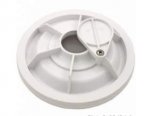First, lets get the terminology correct. What you purchased is a diverter or float valve. The equalizer is, in the case of two or more skimmers, or in a commercial application, a line that runs from the forward, or the hole closest to waters edge in the skimmer, to the pool. Typically, this line will "daylight" through the wall about 2 feet under the skimmer throat.
Purpose:
When the system is running normally, you can adjust the amount of water that is drawn from the forward hole by closing/opening the flapper. Closing the flapper increases the draw from the forward hole. Wide open only reduces the draw, thanks to "path of least resistance".
In the event that the pool water level drops to a level that can no longer supply the skimmer/pump with enough water, your float valve will drop and seal a pathway between the two holes. That will force the pump to draw its water from the forward hole in the skimmer, either the main drain (in the case of a single skimmer), or the equalizer, thus preventing a loss of prime. You can check the operation of this by lifting the weir, preventing water from entering the skimmer, and confirm that the float valve drops and seals. You will know if this happens because the skimmer will fill back up and you will observe no action in the skimmer. You should only hear a brief "slurp" before the float drops. If the slurp goes on for several seconds, your valve is not sealing, and you may loose prime.
Your float valve should have come with a replacement oring that goes in a groove at the bottom of the skimmer. You should use this replacement even if there is one already in place.
IOW, replace it!



